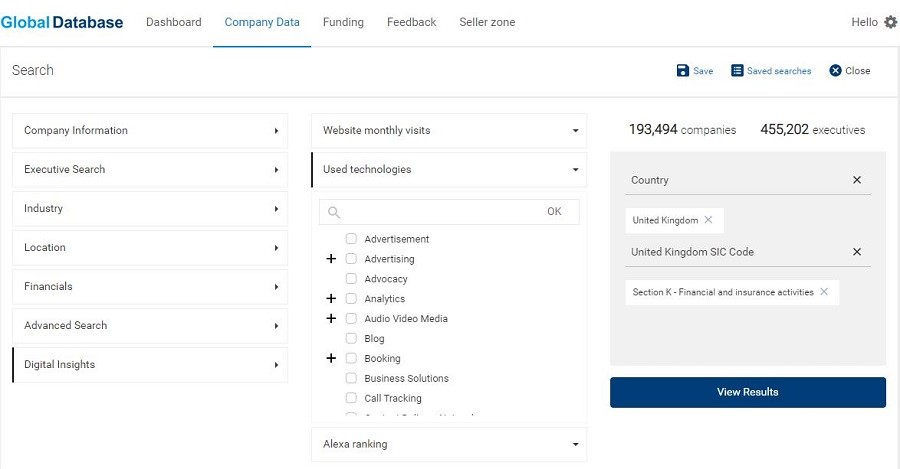Account-based marketing is becoming an increasingly hotter talking point during the last decade. With all the big fuss about its efficiency, the highly-targeted approach is now used in sales and marketing, gaining more and more popularity and winning more advocates to spread the word. However, is it the same when applied to consumers and business partners? Spoiler alert: it is not. In this article, we decided to explain what does account-based marketing mean, especially in the B2B perspective, and how it can impact business-to-business sales.
Is account-based marketing the future of B2B sales? [Infographic]
What is account based marketing?
Account-Based Marketing (ABM) is a targeted strategic approach to business marketing, based on personalized campaigns for accounts (businesses) rather than individuals, industries or markets.
According to the Information Technology Services Marketing Association (ITSMA), ABM is simply defined as ‘treating individual accounts as markets in their own rights’. Founding this approach in the early 2000s, they focused marketing efforts on establishing close business relationships with accounts’ executives and other key figures to meet the individual needs of client companies. Gaining momentum in time, this approach today is considered to be a very promising one to apply in B2B relationships.

Why is account-based marketing important?
We are all strongly used to one-to-many approach. However, B2B mass advertising is a thing of the past. Simply delivering one single message to all your targets will result in too few conversions and end up to be a very inefficient marketing campaign. ABM, though, is the strategic approach that not only uses one-to-one reach, but also addresses separate targeted accounts by goals. Thus it becomes the source of higher value opportunities and increases the returns on marketing investments. A survey by ITSMA had 84% of respondents state that account-based marketing delivers higher ROI than other types of marketing.
ABM and personalisation are walking hand in hand, and we’ve previously argued the core importance of personalisation marketing for B2B. Thusly, the more you concentrate your campaigns around each account or group of accounts, the stronger will be the impact of your high-touch tactics. Moreover, you can immediately notice where improvements are needed and a drawback found in your campaign would affect only one account or just a small group of those, instead of becoming a huge smear on your campaign.
B2B sales are a lot more complex than negotiating and completing transactions with a single individual. In most cases, there are at least several people within a company that make a purchase decision. Each of them can have a different viewpoint, while all these stakeholders of every prospect company are known as its ‘buying center’. Thus, with a personalized approach, chances are higher that the deal will be closed, as more individual perspectives are likely to be covered in the sales offer. Moreover, proving from various angles that your product will bring value to the client may not only result in a one time sale but rather in a long-term business relationship.
Tracking the efforts and results by each account, you can also easily understand whether you need to prioritise, and if so - who of your accounts should come first. Following clear paths with a certain number of accounts, instead of chasing millions of leads without being able to understand their importance for your business, will save you a great bunch of resources.
Yet another advantage of ABM is given by its measurability, as the results are quite easy to track due to a narrow focus and a high degree of personalisation. It is easier to understand which resources refer to each targeted account, resulting in an uncomplicated further optimisation, when necessary. Account-based marketing metrics are somewhat different from traditional ones from two main points of view:
- They concentrate on long-term business relationships rather than immediate revenues. As compared to B2C, B2B most often imply longer sales cycles and considerable transactions.
- They are about quality, not quantity. Instead of focusing on a wide range of new leads, ABM relates to a smaller number of prospects, delivering messages to the right people within targeted companies.

According to HubSpot, there are five main types of ABM metrics, categorised as coverage, awareness, engagement, reach and influence:
- Coverage holds the idea that the information you have about your accounts should be as exhaustive as possible. It should comprise all the data you may need to highly personalize everything you deliver to reach the key people of your target. Additionally, it entails the degree to which accounts are insured with laser-targeted custom content.
- Awareness reflects the popularity of your company among your prospects. You can track that by following traffic share that is assigned to your target accounts, email opening rates, events’ attendance and other indicators, specific to your particular type of business activity.
- Engagement reflects the degree to which your prospects tend to commit and engage with your company.
- Reach helps you understand whether your efforts are unproductive. For that, you’d need to research your results by channels. For example, you may estimate the attendance of an event you are running, track related conversions, and then determine which of those are coming from your key accounts.
- Influence is the metric you should be looking into when discovering data-driven insights. This means you should seek and find the segments of your accounts that, e.g., have one impact or another on your sales, on awareness, on development, and so on.
Nevertheless, these 5 metrics do not exclude, but rather complement the usual assessment of sales, leads and existing pipeline conversion rates.
[[form]]
How does account-based marketing work?
Account-based marketing follows four elemental principles which fully define the essence of the approach. Briefly explained, these can be presented as follows:
- Campaigns tailoring. Combining knowledge about the market and accounts’ personal information from both business representative and individual perspectives, marketers build highly-personalized content, tailored accordingly. As a consequence, targeted accounts receive the most value and become more likely to establish and maintain a long-term business relationship.
- Relationships prioritizing. B2B relationships don’t tend to focus on a one-time sale only. Long-term business relationships are of core importance and that’s where the spotlight lies. Companies should rather build reputation, than simply chase revenues.
- Account-centered operating. Account-based marketing is very much relying on understanding in essence the accounts’ needs and challenges and finding the best solution, instead of simply promoting an existing product.
- Marketing and sales teams coworking. Oftentimes, sales team members are those who know what are the priority accounts and their needs, while marketers are the ones who will know how to solve and deliver them in an attractive way. The best account-based marketing results can be achieved only by means of a close partnership between marketing and sales.
These principles help to easily explain what is account-based marketing funnel and how it is different from the traditional one.
Somewhere in between account-based marketing and content marketing lies the so-called account-based experience. According to the 2017 Social Marketing Industry Report, almost half of respondent B2B marketers mentioned blogging as their essential type of content. The latter helps to both drive and segment the traffic. Thusly, when considered the highly-targeted audiences down to the level of individuals within organisations, content becomes one of the key tools to deliver some of the account-based marketing best practices. This should not be read as a tip to create your content for one specific current or potential business partner. Neither should this be understood that we are talking about written content only (e.g. blog posts). You could rather address particular divisions or job titles, while focusing less on an industry or vertical. In such a way, if you deliver some content that regards the sales department of a specific company you have in mind, it will still refer to all the sales departments at least within the market your target is part of. On top of it all, by delivering quality content in such a way, you will earn in time an expert profile of the given field, adding to the other benefits.

Do not forget, though, that not all content will be suitable for any stockholder of your target. This is why some experts advise to rewrite or re-transmit the same content in different formats, for you to make sure that you not only reach but deliver to all the levels of targeted companies. Creating content that would be both relevant and easy to be modified for each type of audience, will save you time and money in the long run. Thus, you’ll easily be able to tailor the information you deliver by employee level, industry or any other suitable way to hit the mark.
Outbound marketing vs Inbound marketing vs Account-based marketing
Just to remind the difference between these three terms, we’re going to briefly define them. Outbound marketing refers to all marketing messages sent out far and wide in the hope to reach as many consumers as possible and get their attention. Inbound marketing implies delivering (different types of) high-value content, aimed at attracting prospects by offering useful information instead of continuously trying to interrupt them from their ongoing activities. ABM involves high-touch marketing and sales tactics, individually targeting leads which would be the most likely to build long-term business relationships with your company.
High-value content plays a huge role for both inbound marketing and ABM, with just a small difference in the way it is being planned and written. In the case of inbound marketing, content is created with the goal to attract prospects over time: either via organic search, social media or any other channel, prospective customers find the information they seek and thusly learn about your company and values you can deliver. When talking about account-based marketing, prospects are identified first, and content creation only comes after finding out what is important and valuable to these prospects, in such a way nurturing pre-targeted leads. This does not mean, however, that you have to choose between the two approaches. The content you’ve created for your targeted leads will still be found organically by other prospects who will be highly interested in the topics you cover.
As per Hubspot, the way your website appears on Google, as well as on other search engines, is your new business card, while the combination of inbound and outbound is your new marketing mix. Although a quite interesting approach, it pretty much ignores the possibilities account-based marketing has on offer.
Account-based marketing means focusing only on accounts that matter. If you personalise your email marketing campaign, for example, by accounts or small groups of accounts, you will soon start standing out from all that glut of spam your target accounts are eager to avoid or get rid of. Don’t forget, that we are talking about B2B, and hereby mentioned accounts represent businesses and the buying centers thereof.
Account-based marketing & Business intelligence
Various sources suggest keeping an eye on such things as your pre-targeted leads’ social media accounts, blogs, earnings calls and annual reports to identify needs and changes thereof, at least the ones that you can address with your solutions. But this could mean continuous wasteful expectation for any change in your favor - and who would ever do that?

A great solution to identify leads and strategize their targeting at a fast pace comes from business intelligence platforms. Data providers offer you a lot of information about companies and their executive and management teams, so that you could personalise at max your upcoming campaigns and get the most of them. Filtering out businesses according to the criteria you need, you get quality over quantity, and can be sure that your account-based marketing will be truly efficient.
We are not going to compare Global Database account-based marketing solutions to the ones of our competitors as we’ve done it before. However, we will show how our company directory, can bring you closer to some of the highest-probability prospects.
First of all, what you’d need to do, is to apply any of the segmentation tools provided with Global Database company directory for account-based marketing. Thus, you’ll immediately have a list of businesses that fit your ideal customer profile. To further augment the value and opportunities you bring to your company you can use to your advantage any of the following:
- Financial, digital and many other insights - not only can you understand the strengths and weaknesses of your prospects, but also aim directly to the points that would underline the value that your offer can bring to each and every prospect. When addressing them individually, you can truly make them feel that touch of personal in today’s corporate world, and that’s what matters most for a long term business relationship. On top of that, all the information we provide is updated on a daily basis. Hence, when setting up custom alarms tailored to your interests, you can be sure that you will be aware of all changes important to you and your business. This will allow you to have the necessary knowledge right in time to warm up your prospects to the ideal temperature.
- Advanced filters - when applied according to your needs and possibilities, you get right away lists of companies that would have some of the highest probabilities to convert. This allows you to effortlessly use quality over quantity.
- Group structures and executives’ data - having a thorough hierarchy understanding, you’ll easily get an idea of where your prospects are standing and how easy a purchase decision can be made. Stakeholder intelligence supplies you with the right knowledge about the decision makers that you may contact applying high-touch tactics as part of your account-based marketing strategies.
- Highest deliverability rates - as the contact information we list is verified on a daily basis, while the email addresses we feature are validated every month, we guarantee some of the highest deliverability rates on the market. The email deliverability rates recorded by our current users reach up to 95%, a figure none of our competitors can brag about.
Don’t forget that it works both ways. You can access insightful data about your current customers, and build the ideal business partner profile thereon.
To sum up...
In our corporate world, a personal touch is somewhat elusive, especially from the B2B perspective. ABM is the approach that not only allows you to nurture your business partners and prospects individually, but eases tracking the effects of your marketing efforts and may improve overall results. Adding a piece of personal to your messages and other content, as part of account-based marketing, may prove to be a real gem for establishing long-term business relationship.
![Is account-based marketing the future of B2B sales? [Infographic]](/api/image-serving/1400/550?url=https://storage.fileservice.dev/media/009ddd61-59af-4431-b7e1-a8b7ab84d2fd.jpg)